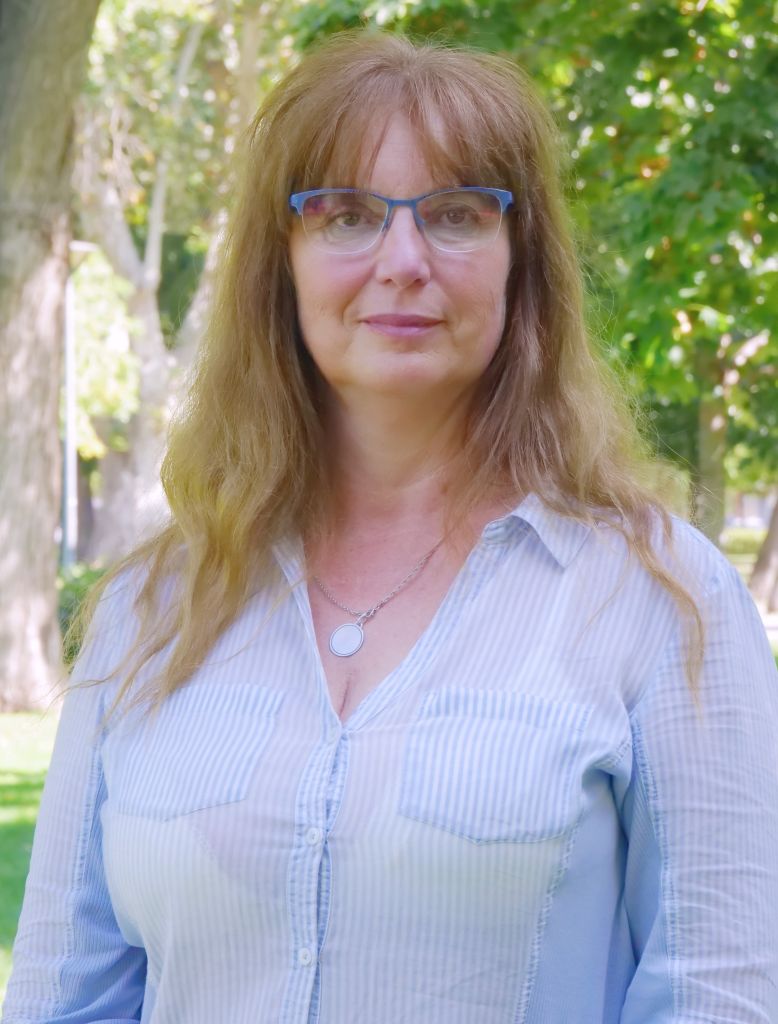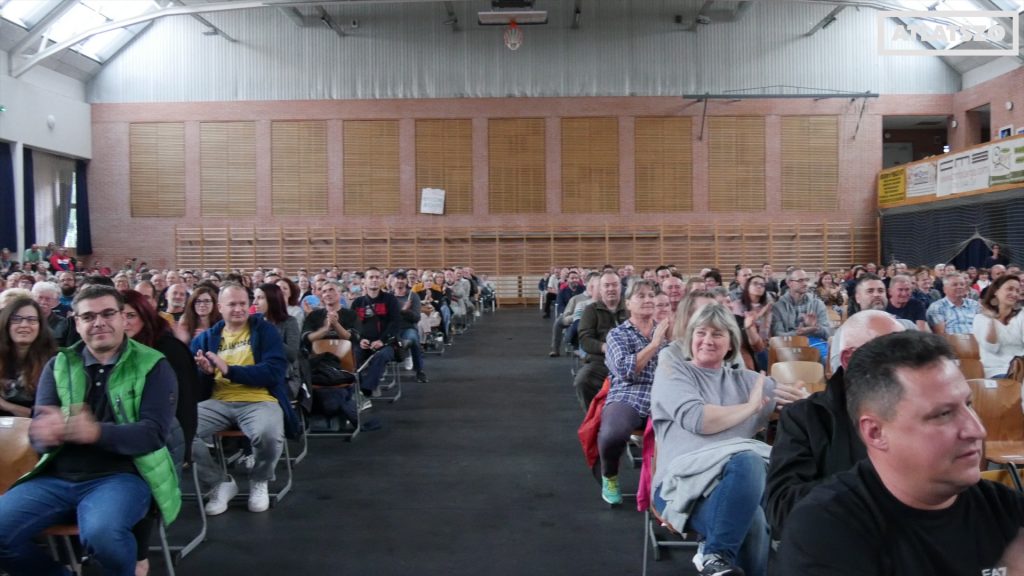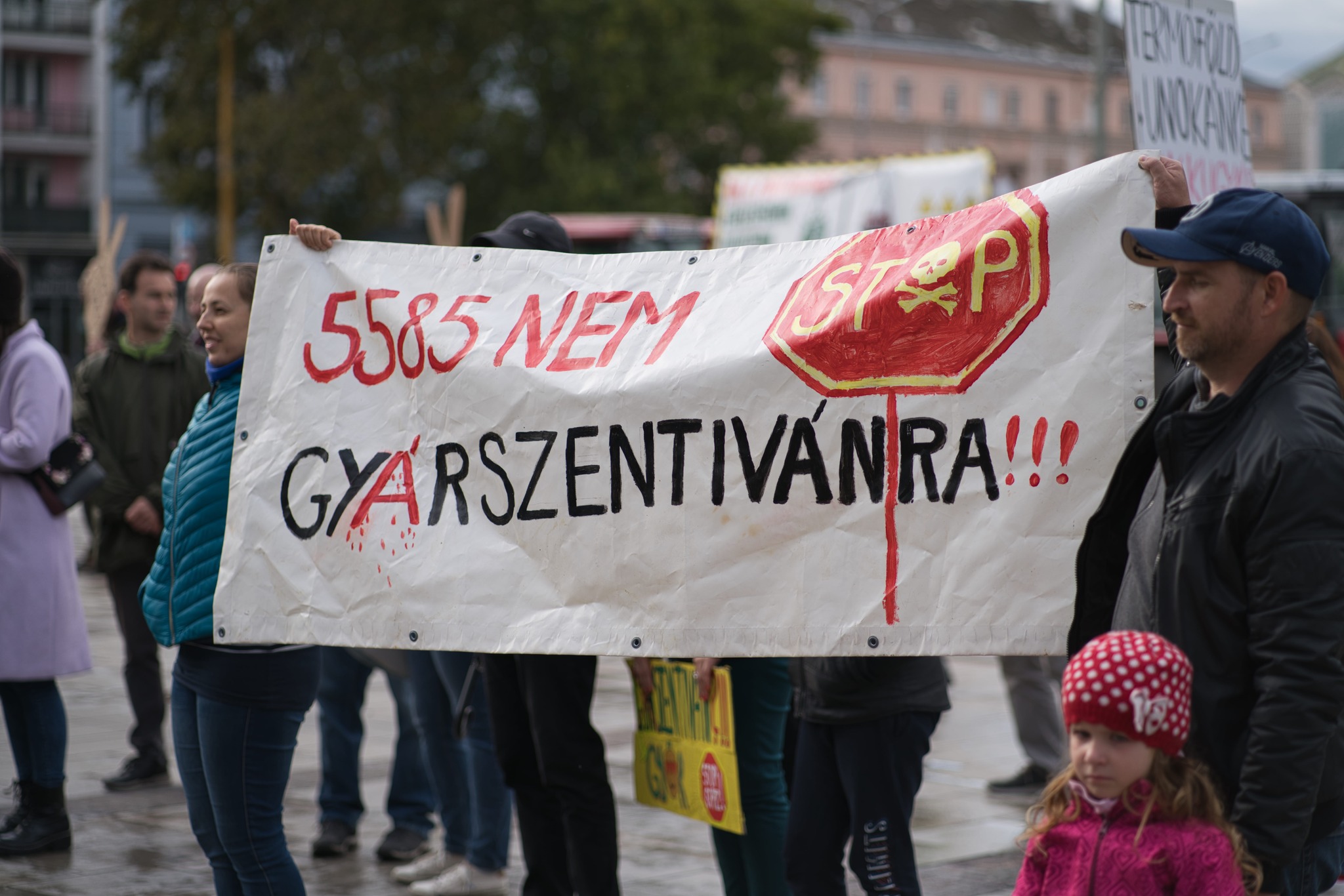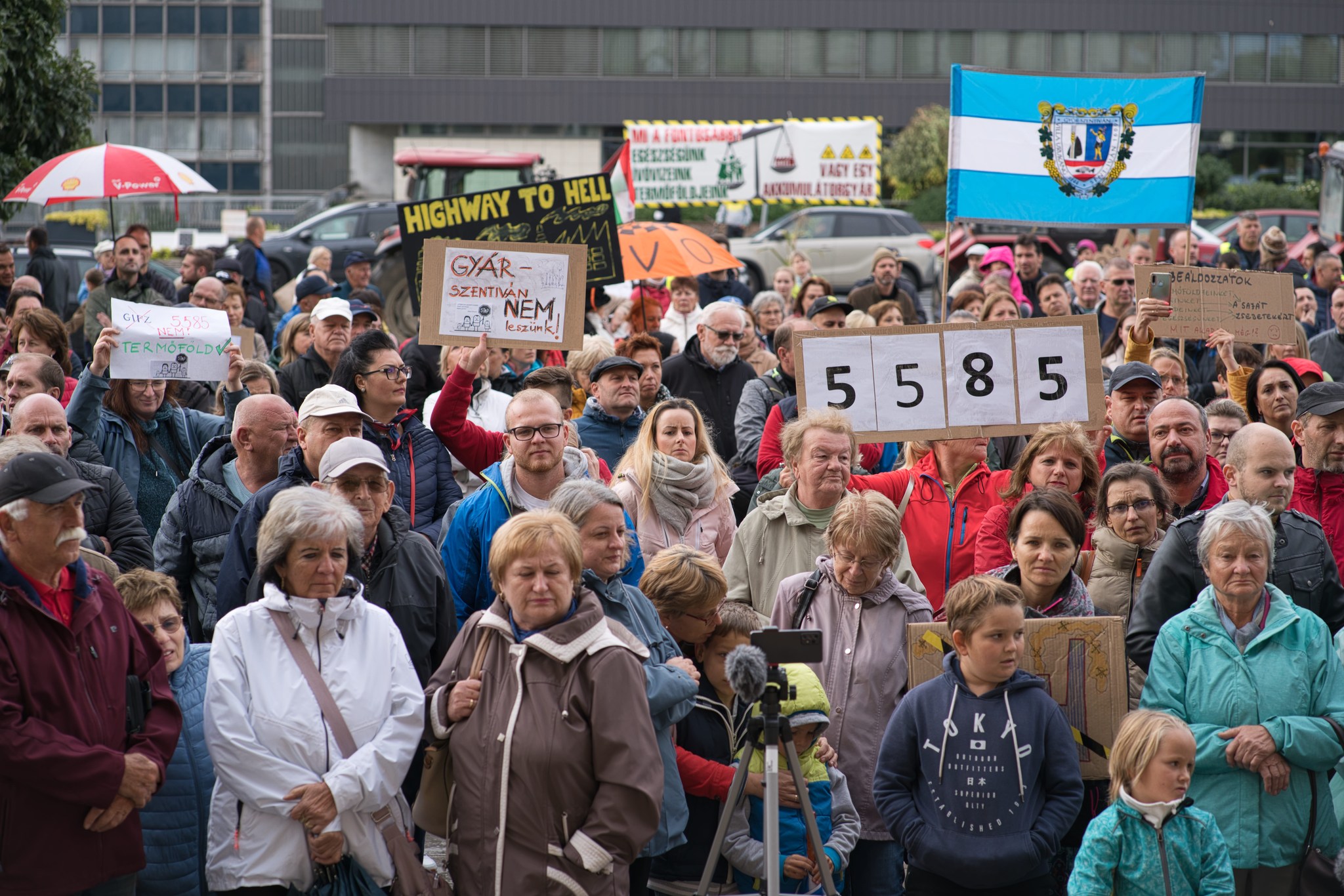The https://english.atlatszo.hu use cookies to track and profile customers such as action tags and pixel tracking on our website to assist our marketing. On our website we use technical, analytical, marketing and preference cookies. These are necessary for our site to work properly and to give us inforamation about how our site is used. See Cookies Policy
Citizens of Győrszentiván protest against planned battery factory, booing government officials at residents’ forum
For two months, there has been a heated debate in Győrszentiván, population 12,000, culminating in a public forum on 20 September. At the event, held in connection with the planned expansion of the industrial park in Győrszentiván, around 1,000 residents demanded answers about the “significantly disruptive” industrial project ordered by the government, but the government and municipal officials present were unable to provide any meaningful answers to their questions.
The residents of Szentiván, once an independent settlement that has been part of Győr since 1970, have been collecting signatures since August, protesting against the unknowing expansion of the Győr industrial park. And the growing protests were visible at the residents’ forum held on 20 September at the Molnár Vid Bertalan Community Centre.

The public demonstration, which started at the beginning of August, was mainly triggered by the fact that, following Government Decree 16/2022 (20 I.), nearly 400 hectares of land in Győrszentivan were declared a priority investment area, and as a result the Győr municipality started the procedure to reclassify the area from an agricultural zone to an industrial zone.
The government decree states that
that the designated sites will create an ‘industrial area with a significant degree of disturbance’.
The Győr municipality has published a partnership consultation document for the rezoning procedure. It lists the characteristics of the “industrial zone with a significant disturbing effect (Gipz)” described in the Győr Building Code, which allows for “industrial activities with a risk of fire, explosion, infection, high noise or foul smell”. However, this is not at all what the people of Győrszentiván want.
According to the mayor, there is a “smear campaign” by political and business circles
The zoning plan has also reinforced suspicions among locals, based on Audi’s development of electric car manufacturing in Győr, that the new industrial park will be home to a battery factory. And the people of Győrszentiván, who are already suffering from the negative environmental effects of industrialisation, certainly do not want such a dangerous plant near their residential area.
So in early August, protesting residents and NGOs set up a Facebook page and Facebook group, and then quickly started writing petitions and collecting signatures against the planned industrial project. The petition was signed by 5,585 residents.
The mayor of Győr, Csaba András Dézsi (Fidesz-KDNP), first tried to reassure the public on his social media page. He stated that although the industrial park will indeed be expanded thanks to a HUF 10 billion state subsidy, an environmental impact assessment will be carried out for the investment.
According to the mayor, it is the opposition that is inciting people against industrialisation. In any case, he received the 5 585 signature sheets, but also warned residents against “political incitement”.
However, it became clear to the locals that the Győr city government did not want to address their concerns, so on 19 September, protesting residents and their supporters demonstrated outside Győr town hall against the land grab and the creation of the industrial park. On the morning of 20 September, the mayor’s proposal for the expropriation of the land in question was nevertheless voted through.
At the assembly, Csaba Dézsi again made the “argument” that only opposition politicians are inciting and scaring locals who, in his opinion, are worried about an environmentally damaging project. The mayor also said he knew that the protesters’ slogan “Don’t pave over farmland” was not motivated by a desire to preserve farmland. According to Mr Dézsi, it is in fact a question of landowners trying to get a higher price than the one set by the valuers.
Clapping and laughing
After the mayor’s statements at the morning assembly, it is no wonder that Csaba Dézsi did not wish to address the residents at the afternoon forum. But he was not the only one to be absent, citing official commitments.
Among the invited guests were Dr. Sándor Sik, the representative of the Győrszentiván municipality, Edit Nagyné Dr. László, the notary of the city of Győr, Dr. János Kálmán, the director of the County Government Office, Dr. Zsolt Buday, the head of the Department of Environmental Protection and Edina Németh, the chief architect of the County Government Office. However, only the invited speakers provided the audience with relevant information.

Dr. János Kálmán and Dr. Zsolt Buday, senior officials of the Győr-Sopron County Government Office at the public forum Photo by Dénes Balogh
Zoltán Kun, a landscape and horticultural engineer and conservationist, gave a presentation on the negative consequences of the expansion of the industrial park and the loss of arable land. He spoke about the fact that the planned rezoning is contrary to Győr’s adopted climate protection strategy, and that the combined environmental and health effects of the planned industrialisation and the related infrastructure investments should be examined.
Negative health trends are already present in the settlement, according to the speeches of Dr. Györgyi Beáta Kovács, a general practitioner, and Dr. Éva Petrovicz, a paediatrician. They said that in the last 7 years the rate of cancer has increased by 20 percent in Győrszentiván, and the number of asthma cases among children has risen from 58 to 107 in three years.
While the speeches of Zoltán Kun and the two doctors were accompanied by approving applause, the answers of the invited officials and Sándor Sik to the residents’ questions were met with a lively disagreement, with several whistles and loud laughter.
They tried to hide behind the government decree
Locals have tried in vain to find out, among other things, what the investment of major national economic importance really means, and whether a battery factory or other hazardous industrial plant could be expected in the 400-hectare industrial park. In almost all cases, the answers were the same:
the invited guests knew absolutely nothing about the purpose of the government’s plans to create a new industrial park near the houses in Győrszentivan, and for whom.
For example, Edit Nagyné Dr. László kept wondering why the residents “don’t understand” that they could not find out anything because of the priority investment status. “When I find out what kind of investment it is, I will tell you”, she said, referring to the thousands of such projects that the Hungarian government has decided on without consulting the local people and without their knowledge.
The Győrszentivan forum, however, showed that what is perfectly obvious to the officials is unacceptable to the residents concerned. The latter do not consider it ‘natural’ that the decision taken over their heads should be kept secret from them – but officials carry out the instructions of the government decree even if they have no idea of its content.
At the en of the forum, Andrea Szabó, executive director of the Szentiván Öko Szeglet (SZÖSZ) Association, asked for the support of those present to carry out air and water pollution measurements by independent companies to assess the environmental condition of the neighbourhood.
We also asked Zoltan Kun about the usefulness of the forum. He said the extraordinary activity and awareness of the population made it clear that the will of the people living here must be taken into account when decisions are made on Győr’s development and that the opinions of citizens cannot be swept aside in the way they have been.
Translated by Zita Szopkó. The original, Hungarian version of this story was written by Zsuzsa Bodnár and can be found here. Photos and video: Dénes Balogh




